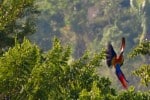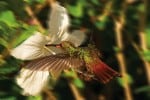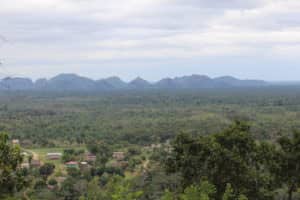
It’s an early morning rise and we can’t help to smile when the familiar words ‘the early bird catches the worm’ rings true in our ears! Only, this bird we are setting out to see feeds off the abundance of the tropical forest fruits and our early morning journey takes us straight to their favorite breakfast table. Geared with our choice of light weight pants, best hiking shoes and favorite lens, we set out on our treasure hunt – to find one of the most beautiful Belizean Jewels…
We start off our adventure to see the Scarlet Macaws on the Southern Highway, passing through orange orchards, banana plantations and small Mayan villages, and we are reminded of how different life is here in a tropical paradise. At a small sign pointing westward towards Red Bank Village, we turn. Why Red Bank? Because this magnificent fairy tale-like creature choose mountains above a small Mayan village as their feeding grounds, amounting to the largest concentration of Scarlet Macaws not only in Belize, but the entire Central American region. We exchange our paved road for a narrow dirt path as we bump along. Four miles into our dirt road journey is our first stop, where we purchase our tickets to our Scarlet Macaw extravaganza.
Red Bank made a name for itself only recently when the story of the large flocks of Macaws coming out of the Chiquibul Forest Reserve every December through March to feed off the ‘annatto’ and ‘pole wood’ trees, became known. Other stories started spreading too, stories of local villagers including the Macaws in their daily diet. The Belize Audubon Society and other Conservation Programs were forced to immediately come up with a plan to save the Scarlets. Their plan included educating the villagers on the importance of this bird as well as introducing and setting up the concept of a tourism venture in which the birds may possibly be financially beneficial to the villagers’ livelihood. Several of the villagers familiar with the birds’ migration patterns and feeding habits were officially trained as licensed tour guides. The ‘Scarlet Macaw Group’ was formed with members from the village and the Scarlet Macaws are now benefiting the village and its people in generating a sustainable income.
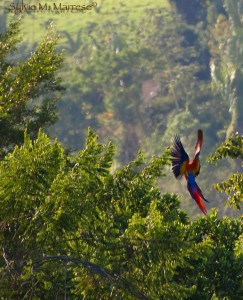
With permit in hand, we drive to the outskirts of this quaint Mayan Village into the neighborhood of the Scarlet Macaw. Soon we discover that this area is home to hummingbirds, herons, toucans, oropendolas and various other parrots too. We start our steep 20 minute hike (on days that the skies drench Mother Earth with water, road access is impossible and a 20 min hike becomes about an hour) when we reach our first of four lookout spots. These lookouts are humble clearings made and maintained by village members to ensure the best view of the Scarlet Macaw extravaganza. It is on this trail towards the lookout that you first hear the distinctive “early morning market chatter” of the macaws. Scarlets primarily communicate through raucous honks, very loud, high and sometimes low-pitched, throaty squawks, squeaks and screams. This very vocal communication of the Macaw is highly variable and is designed to carry over distance, enabling them to call for their groups.
Focusing on what at first might appear as ripe fruit in a distant tree, suddenly as our eyes and ears register the vibrant colors of the magnificent creatures, we start realizing the significance of this great blessing of Belize!
The noisy chatter of the Scarlet Macaw matches its abundance in color. We cannot help but to wonder which rainbow did they steal their color from. The plumage is mostly scarlet, the rump and tail-coverts feathers a light blue. Then, our eyes catch the greater upper wing coverts of buttercup yellow, the upper sides of the flight feathers in dark blue and as our eyes follow to the ends of the tail feathers, we see how blue spills into dark red and metallic gold on the undersides of the wing and tail feathers. Juveniles have dark eyes where as adults have light yellow eyes.
All Macaws family members have bills that are deeply hooked and feet that are zygodactyl. This means they have two toes pointing forward and two toes pointing back, which allows for walking through the trees of the jungle canopy and lifting their food to their bill.
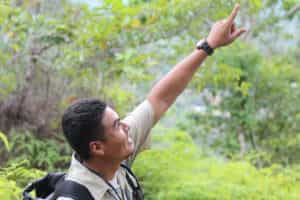
Watching our sassy Macaws’ early morning family routine, we realize that they are full of personality, energy and whit. We get to observe their behavioral quirks and habits. It becomes very evident that they are definitely not solitary birds. For them, numbers count, and they prefer living in larger groups. When watching them for a little while, we notice that they don’t only communicate with sound, but with their posture also.
Scarlet Macaw couples are real romantics and are very keen parents. The pairs form monogamous bonds that last their entire life span. That life span can be between 50 years in nature or 70 years in captivity. Very little is known about their breeding patterns, however, it appears that even though they are comparatively docile, Scarlet Macaws may turn formidably aggressive during breeding. The hen lays an average of two white, non-glossy, non-speckled eggs in a tree cavity. Both females and males are responsible for incubating the eggs. The incubation period is about five weeks, and our new naked hatchlings will remain in the nest for 3 months. Mom and Dad Macaw will then urge their juniors to fledge, and teach them the ways of being a wild Scarlet Macaw. One year later our juveniles leave the care of parents and five years later reaches sexual maturity. Scarlet macaws can grow up to 35 inches, (about three feet or about 81cm), weigh about 1kg or 2lbs and can fly up to 35 miles per hour, scouting for clumps of their favorite food.
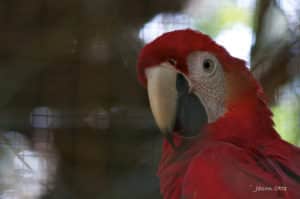
Visiting the Scarlets’ breakfast table and observing these intriguing creatures, we might walk away saddened when we are reminded that though we view them in multitudes, multitudes in numbers is not the full story of the Scarlets. The full story of the Scarlets goes along with endangered numbers due to human greed – becoming a commodity in the pet trade and reduction in numbers due to deforestation. One good thing we have taken from the captive techniques developed from the pet trade: in areas with low Macaw populations, the “extra” babies that typically die in the nest may be reared by human hands and released into the wild to bolster the population – and this in turn, will positively affect our wild populations!
